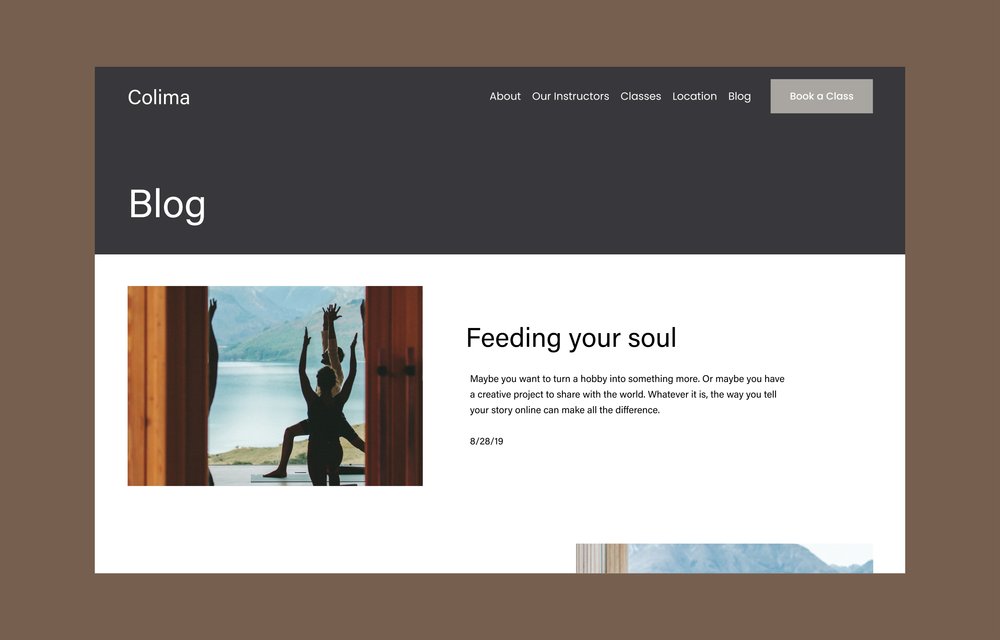Learn how to build an engaging and profitable blog with our free guide.
The email you entered is invalid.
Thank you for subscribing.
By entering your email, you indicate that you have read and understood our Privacy Policy and agree to receive marketing from Squarespace.
There are numerous benefits to adding a blog section to your business’s website, including the potential for higher site traffic and increased sales. Business blogging gives you a platform to create a deeper connection with your customers by telling them the story behind your business, keeping them updated on where the business is going, or showcasing your industry expertise, which could help your business become a thought leader on a particular topic.
This guide will walk you through some specific strategies that will help your business get the most out of your blogging efforts.
Indirectly selling to your audience
How should a business use a blog? When you created a site for your business, the message was likely direct: this is who we are, this is where we are, this is what we sell, and this is why you should buy it. Adding a blog provides a space on your business’s website to connect with customers without simply sharing matter-of-fact information like that or directly selling to them.
A blog could be a place where you look to the past by describing your background and how your company came about. Audiences love an origin story, and a blog gives you a place to tell yours. You could also use a blog to look to the future, describing where your business is today and what new developments are coming soon—from new products or sales, to emerging topics in your industry that your business has a unique perspective on.
You’ll want to be mindful of your message when you start blogging for business. Be careful to deliver a consistent message to build your brand and strengthen your relationship with your customers. It’s important to consider both your brand message and voice when blogging for companies.
Brand message. The value your brand provides to your customers and how you differentiate your business from your competitors determine your brand message.
Brand voice. The personality of your brand might be playful or earnest, humorous or aspirational, or more formal and educational, depending on your business goals and how you best connect with your audience.
Making your blog discoverable
After spending the time and energy to create a blog, it’s time to make sure your target audience can find it. At minimum, add a link to your site’s navigation bar for your blog page. Readers start at the top of your page, so a callout there is much more effective than adding a mention of your blog at the bottom of your page or somewhere in the middle where it could get overlooked.
Understanding basic site navigation will help you integrate your blog into your website’s design. Plus, adhering to those basic website navigation tenets can also improve the functionality and performance of your overall website, which can benefit your business.
Improve site functionality and performance with:
Responsive design. With a responsive design, the elements of your site (including the navigation bar, text, images, and buttons) remain consistent across different devices with varying screen sizes, from mobile devices to desktop displays.
Sticky navigation bar. A navigation bar that appears at the top of each page of your site ensures that users never get lost and can easily find their way to the other pages of your site.
Breadcrumbs. The indicators at the top of a page that act as guideposts to let readers situate themselves on your site, breadcrumbs build a pathway through your site content. On a food blog, the breadcrumbs could look something like this: Home > Blog > Taco recipes > Pressure-cooker carnitas. Breadcrumbs also improve your site’s search engine optimization (SEO) because search engines use breadcrumbs to understand and categorize a site’s contents.
It’s important to also make sure that you regularly update your business’s blog. That’s an SEO tactic that can help raise your site’s position in search results. Websites with fresh content get indexed in search results pages more frequently, which gives your site better odds of rising in search rankings and showing up sooner when someone searches using keywords relevant to your content. Ultimately, that leads to more traffic—helping you reach your business goals.
Building a members-only experience
Using a blog to increase the traffic to your site can be good for business, and your blog itself could also be used as a source of revenue. If you have an audience that’s hungry for your content and views you as an authority, then you might experiment with a Member Site, which is a members-only portion of your blog where posts are gated behind a paywall. Consider your audience: Would a segment of your readers pay for access to exclusive content like that?
Squarespace’s Member Sites lets you create a paid section of your blog for premium content. You can set the cost and structure of a membership, whether it’s a one-time fee or a recurring monthly subscription. For a food blog, you might offer exclusive recipes or one-on-one cooking classes for your members. You’ll not only earn money from charging for Member Site access, but you can also build a strong community of subscribers that can help grow your business.




